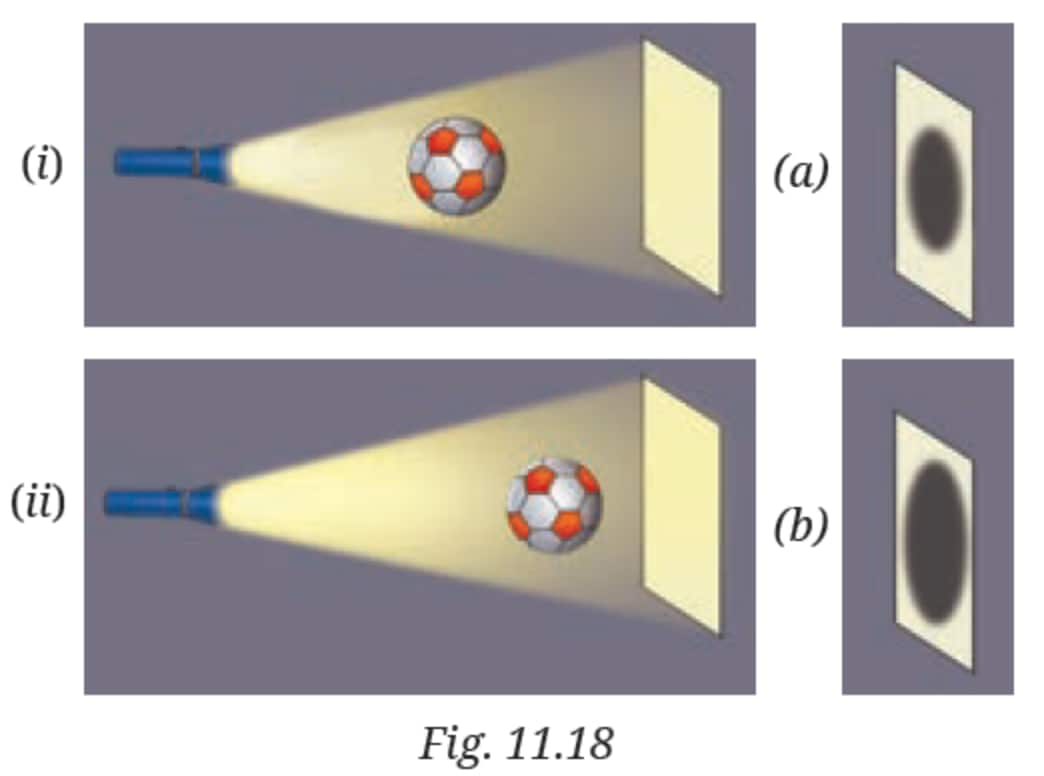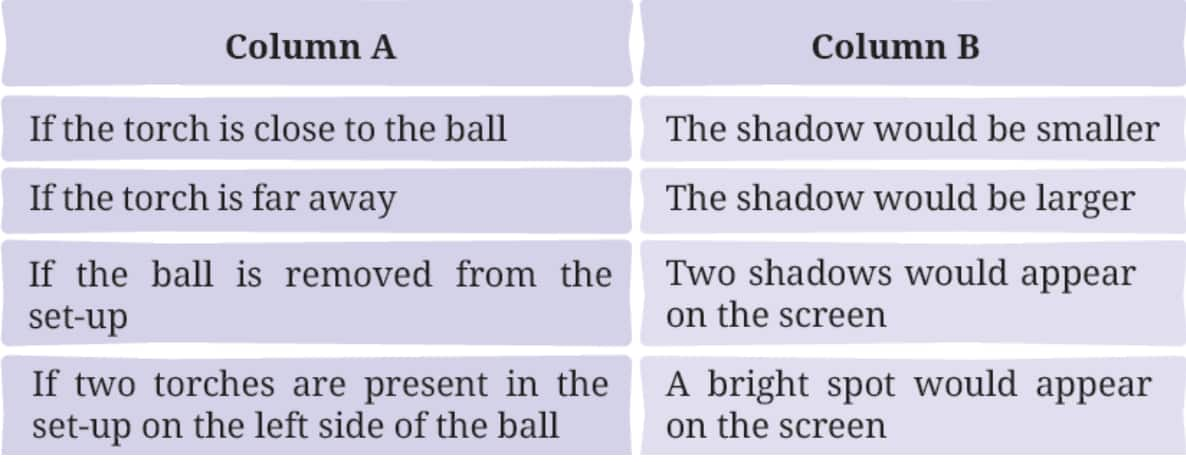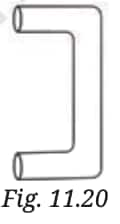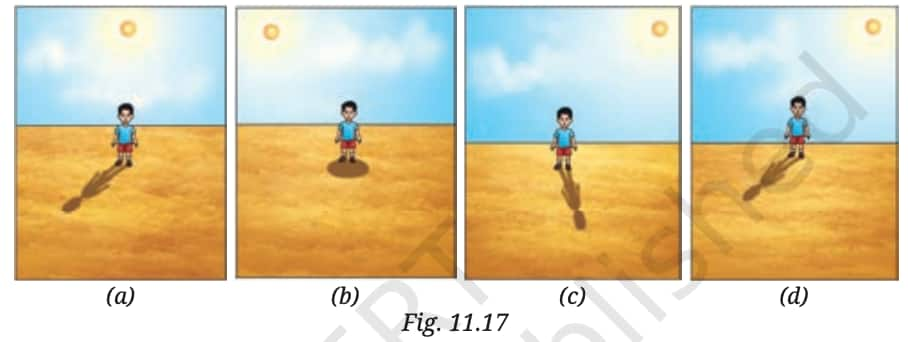NCERT Solutions for Class 7 Science Chapter 11 Light: Shadows and Reflections
The best example of how light works is taking a look at a still pond and seeing your reflection. Chapter 11 of Class 7 Science - Light: Shadows and Reflections assists students to learn about the marvellous world of light, its nature, and how it contributes to the creation of images. The science behind shadow, formation of images, and the operation of simple devices such as the pinhole camera and periscope are some of the key areas that are discussed in this chapter in a simple and captivating way.
This Story also Contains
- Download Class 7 Science Chapter 11 - Light: Shadows and Reflections Question Answers PDF
- Light: Shadows and Reflections NCERT Solutions: Exercise Questions
- Class 7 Science Chapter 11 - Light: Shadows and Reflections: Additional Questions
- NCERT Solutions for Class 7 Science Chapter 11: Topics
- Approach to Solve Questions of Class 7 Science Chapter 11: Light: Shadows and Reflections
- Benefits of NCERT Solutions for Class 7 Science Chapter 11
- NCERT Solutions for Class 7 Science: Chapter-wise links
.jpg)
The NCERT Solutions for Class 7 Science Chapter 11 - Light: Shadows and Reflections give step-by-step responses to all questions in the textbook, such that a good conceptual learning is facilitated. Laws of reflection, formation of shadows and their practical uses in life will be taught by way of simple explanations and by systematic solutions to the students. These NCERT solutions are designed according to the new NCERT syllabus (2025-26), thus making the process of preparing exams less demanding, enabling students to revise within a comparatively short time, and enabling students to become confident in their ability to handle both theory-based and application-based questions. Practising with NCERT Solutions for Class 7 Science Chapter 11 - Light: Shadows and Reflections, students will be able to enhance the conceptual knowledge of light, get to know how to structure answers in a format, write in brief and quick revision before exams and become confident in solving theoretical and application-based questions.
Download Class 7 Science Chapter 11 - Light: Shadows and Reflections Question Answers PDF
Light: Shadows and Reflections Class 7 question answers are in an easy-to-download PDF format that enables students to study well before taking the exams. These class 7 science chapter 11 Light: Shadows and Reflections question answers offer step-by-step solutions to every question of the textbook, and it is based on the key aspects of reflection, like laws of reflection, image formation, shadow formation, pinhole camera, and periscope. Through this free PDF, students are able to update at any time and from anywhere on a mobile, laptop, or tablet device and do not necessarily need to be connected to the internet. The Class 7 Science Chapter 11 - Light: Shadows and Reflections question answers that are developed by subject experts in accordance with the current NCERT syllabus (2025-26) help the students to have a clear understanding of the concepts, to save time when revising and to achieve higher marks when taking examinations. These class 7 science chapter 11 Light: Shadows and Reflections question answers will be the best companions in exam preparation, homework support, and revision exercises.
Light: Shadows and Reflections NCERT Solutions: Exercise Questions
The Light: Shadows and Reflections Class 7 question answers offer solutions in easy and a step by step manner to all the questions in the exercises, to equip the students to comprehend concepts such as, formation of shadow, making of images and reflection. These class 7 science Light: Shadows and Reflections question answers facilitate revision and enhance conceptual understanding and equip students well to sail through exams.
Q1. Which of the following are luminous objects? Mars, Moon, Pole Star, Sun, Venus, Mirror
Answer: The luminous objects are the Sun and the Pole Star. Mars, Moon, Venus, and Mirror are non-luminous objects because they do not emit their own light; they reflect light from other sources.
Q2. Match the items in Column A with those in Column B.

Answer:
| Column A | Column B |
|---|---|
| Pinhole camera | Forms an inverted image |
| Opaque object | Blocks light completely |
| Transparent object | Light passes almost completely through it |
| Shadow | The dark region formed behind the object |
Q3. Sahil, Rekha, Patrick, and Qasima are trying to observe the candle flame through the pipe as shown in Fig. 11.16. Who can see the flame?
Answer:
Rekha can see the candle flame because she is looking through a straight pipe, and light travels in a straight line. Sahil, Patrick, and Qasima cannot see the flame because their pipes are bent.
Q4. Look at the images shown in Fig. 11.17 and select the correct image showing the shadow formation of the boy.
Answer: The correct image is (b). The shadow of the boy should be a dark silhouette with the same shape as the boy, formed on the screen behind him when light is blocked.
Q5. The shadow of a ball is formed on a wall by placing the ball in front of a fixed torch, as shown in Fig. 11.18. In scenario (i), the ball is closer to the torch, while in scenario (ii) the ball is closer to the wall. Choose the most accurate representation of the shadows formed in both scenarios from the options provided (a and b).

Answer: The correct option is (a). In scenario (i), when the ball is closer to the torch, the shadow is larger. In scenario (ii), when the ball is closer to the wall, the shadow is smaller.
Q6. Based on Fig. 11.18, match the position of the torch in Column A with the characteristics of the ball’s shadow in Column B.

Answer:
| Column A | Column B |
|---|---|
| If the torch is close to the ball | The shadow would be larger |
| If the torch is far away | The shadow would be smaller |
| If the ball is removed from the set-up | A bright spot would appear on the screen |
| If two torches are present in the set-up on the left side of the ball | Two shadows would appear on the screen |
Q7. Suppose you view the tree shown in Fig. 11.19 through a pinhole camera. Sketch the outline of the image of the tree formed in the pinhole camera

Answer:
The image of the tree in a pinhole camera will be upside down (inverted). The outline will show the tree with its top pointing downward and the trunk pointing upward, maintaining the same shape and colours but flipped vertically.
Q8. Write your name on a piece of paper and hold it in front of a plane mirror such that the paper is parallel to the mirror. Sketch the image. What difference do you notice? Explain the reason for the difference.
Answer:
The image of your name in the mirror will appear reversed from left to right (laterally inverted). For example, if your name is “RAJ,” it will look like “JAR” in the mirror. This happens because a plane mirror causes lateral inversion, where the left side of the object appears as the right side in the image.
Q9. Measure the length of your shadow at 9 AM, 12 PM, and 4 PM with the help of your friend. Write down your observations: (i) At which of the given times is your shadow the shortest? (ii) Why do you think this happens?
Answer:
(i) The shadow is the shortest at 12 PM.
(ii) This happens because, at 12 PM, the Sun is directly overhead, so the light rays are almost vertical, making the shadow shorter. At 9 AM and 4 PM, the Sun is lower in the sky, so the light rays are slanted, causing longer shadows.
Q10. On the basis of following statements, choose the correct option. Statement A: Image formed by a plane mirror is laterally inverted. Statement B: Images of alphabets T and O appear identical to themselves in a plane mirror.
(i) Both statements are true
(ii) Both statements are false
(iii) Statement A is true, but Statement B is false
(iv) Statement A is false, but Statement B is true
Answer:
(i) Both statements are true. Statement A is true because a plane mirror causes lateral inversion. Statement B is true because the alphabets T and O are symmetrical, so their images in a plane mirror look identical to the original letters.
Q11. Suppose you are given a tube of the shape shown in Fig. 11.20 and two plane mirrors smaller than the diameter of the tube. Can this tube be used to make a periscope? If yes, mark where you will fix the plane mirrors.

Answer :
Yes, the tube can be used to make a periscope by placing two plane mirrors at 45° angles, one at the top to reflect light downward, and one at the bottom to direct it to the eye.
Q12. We do not see the shadow on the ground of a bird flying high in the sky. However, the shadow is seen on the ground when the bird swoops near the ground. Think and explain why it is so.
Answer:
A bird flying high casts a large, faint shadow that's hard to see. When it flies close to the ground, the shadow becomes smaller, sharper, and clearer.
Class 7 Science Chapter 11 - Light: Shadows and Reflections: Additional Questions
The Additional Questions Chapter 11 - Light: Shadows and Reflections of Class 7 are useful so that students can understand how light interacts with different objects. These questions will encourage the students to learn about such concepts as the formation of shadows, clarity of reflections and the way mirrors operate. Doing them will enhance their observation abilities, as well as make students relate classroom knowledge to real-life tasks like observing their reflection or watching shadows change throughout the day.
Q1: It was observed that when the distance between an object and a lens decreases, the size of the image increases. What is the nature of this lens? If you keep on decreasing the distance between the object and the lens, will you still be able to obtain the image on the screen? Explain.
Answer:
This happens when the object that one has and the distance of which to the lens is shortening and the size of the image is growing, we have to decide what kind of lens should we have. The lens that undergoes such a behavior is a convex lens. The passage of light through lenses with a convex shape causes the lenses to bend them, creating a bigger image as the object approaches the lens.
As we further reduce the distance between the lens and the object the image will become virtual. A virtual image is formed when the object is placed within the focal length of the lens. This virtual image cannot be projected onto a screen because the light rays do not actually converge; they only appear to diverge from a point behind the lens.
Q2: The side mirror of a scooter got broken. The mechanic replaced it with a plane mirror. Mention any inconvenience that the driver of the scooter will face while using it?
Answer:
The main problem for the driver will be the inability to observe the vehicles behind them spread over a wider region. The driver might not be aware of cars coming from the sides or behind, which could result in dangerous actions or collisions.
Q3: A rainbow can be seen in the sky
(a) when the sun is in front of you.
(b) when the sun is behind you.
(c) when the sun is overhead.
(d) only at the time of sunrise.
Answer:
The correct answer is (b) When the sun is behind you
The rainbows occur when the sunshine is passing through the raindrops and the light is refracted and dispersed into various colors. To see the rainbow the sun must be shining in the back of you and the water in the front of you.
The reasons why other alternatives are not correct:
(a) Sun in front of you: The sun in front of you implies that the light is not falling at a right angle on raindrops in order to form a rainbow.
(c) In the case of the overhead sun: In cases where the sun is overhead the sunlight fails to pass through the raindrops at an angle that would create a rainbow.
(d) At sunrise only: Although sometimes rainbows can be observed at sunrise or sunset because of the special atmospheric conditions at these moments, it is possible to observe them at all moments of the day when there is sunlight in the sky and rain-drops in the air.
NCERT Solutions for Class 7 Science Chapter 11: Topics
The Light: Shadows and Reflections class 7 question answers, help to understand the key aspects, such as the properties of light, shadow formation, the principle of reflection, and how simple optical instruments work. These are solutions that enable the students to learn fast and implement the knowledge in real life.
11.1 Sources of Light
Luminous sources emit light independently (such as the Sun, bulbs, candles), whereas non-luminous instead reflect the light emitted by luminous sources (such as the Moon, books, walls). These concepts can be used to understand why we can perceive various objects.
11.2 Does Light Travel in a Straight Line?
Light always propagates in straight lines and this is referred to as the rectilinear propagation of light. This concept illustrates why and how shadows are formed and it can be discussed by conducting experiments such as placing light through holes in stacked cardboard paper.
11.3 Light through Transparent, Translucent, and Opaque Materials
Transparent: Allow light to pass completely (glass, clean water).
Translucent: Allow partial light (frosted glass, oiled paper).
Opaque: Do not allow light to pass (wood, metal).
This property affects how clearly we can see through different materials.
11.4 Shadow Formation
Shadow is cast by obstructing light with an opaque object. The shadow will be determined by the shape of the object and the direction of light. The shadows would always appear on the opposite side of the light source and the shadows are dark since light cannot penetrate the object.
11.4 Reflection of Light
Reflection occurs when light bounces off a smooth surface like a mirror. The law of reflection states that the angle of incidence equals the angle of reflection. Reflection enables us to see ourselves in mirrors and also plays a role in devices like periscopes.
11.5. Images Formed in a Plane Mirror
Plane mirrors create virtual, erect and laterally inverted images of the same size as the object. This is the reason why things are inverted in mirrors and why we are able to see ourselves clearly in it.
11.6 Pinhole Camera
A simple device that shows how light travels in straight lines. It forms an inverted image of an object on the screen inside the camera. Pinhole cameras have no lens and are often used in experiments to understand image formation.
11.7 Periscope
An optical instrument that allows viewing above or around an obstacle, based on two plane mirrors at angles of 45 degrees. The light principle of periscopes works with numerous reflections of the light and is usually implemented in submarines.
11.8 Kaleidoscope
An instrument with mirrors and coloured slivers of glass or paper which reflect one another several times and produce exquisite geometrical patterns. It proves that light and reflection may form various complex designs.
Approach to Solve Questions of Class 7 Science Chapter 11: Light: Shadows and Reflections
Light: Shadows and Reflections can be described as the chapter that makes students acquainted with the interesting nature of light actions and illumination, the formation of shadows, and reflection principles. Students are advised to pay attention to conceptual clarity and real-life examples to answer questions related to this chapter. Here's a smart approach:
- Light moves in a straight line at all times and therefore, you should remember this point of light when answering questions on shadows and reflections.
- The object creates a shadow when it blocks light, where the colour of the object in the question is opaque, transparent, or translucent.
- Try to observe the way mirrors reflect the light and how images are created and learn to draw simple diagrams where you are able to see how the light gets reflected back.
- Use real-life examples to explain your answers easily i.e., the way your shadow changes throughout the day or the way you can see yourself in a mirror.
- Answer your questions with key words such as reflection, source of light, mirror, and shadow to make your answer more accurate.
- Always draw clear and well labeled diagrams wherever necessary.
- Practice your NCERT questions and examples on a regular basis in order to memorise the concepts.
Benefits of NCERT Solutions for Class 7 Science Chapter 11
Class 7 Science Chapter 11 - Light: Shadows and Reflections question answers prepare the students with an ordered and clear approach to the understanding of simple concepts of light. The solutions have been used to explain significant concepts like shadow formation, light ray behavior, mirror reflection, and how simple machines such as the pinhole camera and the periscope work in a simple followable manner. They can be of great help in preparing exams, practicing homework and putting science into practice in real life. Through these Light: Shadows and Reflections NCERT Solutions, the students are able to develop a solid foundation in the study of light and its uses.
- Clear Concept Understanding: Describes difficult concepts such as rectilinear propagation of light, reflection, and formation of shadows with simple and step-wise language. Assists in developing a solid science base with real-life illustration examples.
- Well-Structured Answers: Gives correct, sharp and exam-oriented solutions to exercises as per CBSE/NCERT marking scheme.
- Boosts Exam Performance: Covers some of the significant keywords, definitions, and diagrams that have been found in test papers. Provides an understanding of the procedures for writing answers to achieve more marks.
- Supports Self-Study: Without any external assistance, the students can revise easily since the explanations are straightforward and can be understood easily. Serves as an immediate guide in the last-minute preparation.
- Improves Application Skills: Provides practical examples and hands-on activities that relate theory to practice, such as a pinhole camera, periscope, and kaleidoscope.
- Aligned with Updated Syllabus: According to the current Class 7 NCERT Science syllabus only, without any outdated or irrelevant items.
NCERT Solutions for Class 7 Science: Chapter-wise links
The NCERT Solutions Class 7 Science is a step-by-step solution to all textbook exercises and questions. This makes it easy to solve problems and, most of all, to prepare well in time to pass the examination. These chapter-wise links make quick navigation and targeted revision beneficial, and in-depth coverage of the new syllabus.
NCERT Solutions for Class 7 Subject Wise
Also Check NCERT Books and NCERT Syllabus here
Frequently Asked Questions (FAQs)
Step-by-step instructions, CBSE-styled responses, explanations of complex concepts like reflection, lateral inversion, shadow and a variety of question formats are all provided by NCERT Solutions. According to 2025–2026, Learning Light is more relatable thanks to its visuals and real-world situations, which also increase exam accuracy.
The chapter predominantly describes how light travels, makes shadows, shadows and generates reflections and how a pinhole camera and a periscope works.
The surface of a mirror is smooth and shiny and it gives a straight reflection of light whereas a wall surface is uneven and causes light to spread across directions.
Opaque, transparent and translucent, depending on the quantity of light that will get through them.
Shadow forms when a light source is blocked by an opaque object, and a reflection forms when the light does a bounce-back on the surface.
It operates based on the understanding that light moves in a straight path.
Common mistakes that are solved by NCERT Solutions include misunderstanding of different kinds of images, mistaking lenses for mirrors, and using the law of reflection improperly. Conceptual explanations and step-by-step practical examples aid in avoiding these mistakes
Courses After 12th
Applications for Admissions are open.
As per latest syllabus. Physics formulas, equations, & laws of class 11 & 12th chapters
JEE Main Important Chemistry formulas
Get nowAs per latest syllabus. Chemistry formulas, equations, & laws of class 11 & 12th chapters
JEE Main high scoring chapters and topics
Get nowAs per latest 2024 syllabus. Study 40% syllabus and score upto 100% marks in JEE
JEE Main Important Mathematics Formulas
Get nowAs per latest syllabus. Maths formulas, equations, & theorems of class 11 & 12th chapters


